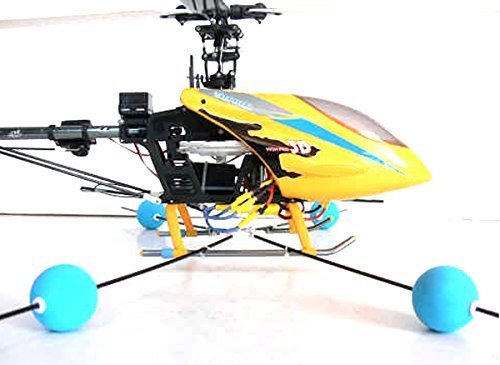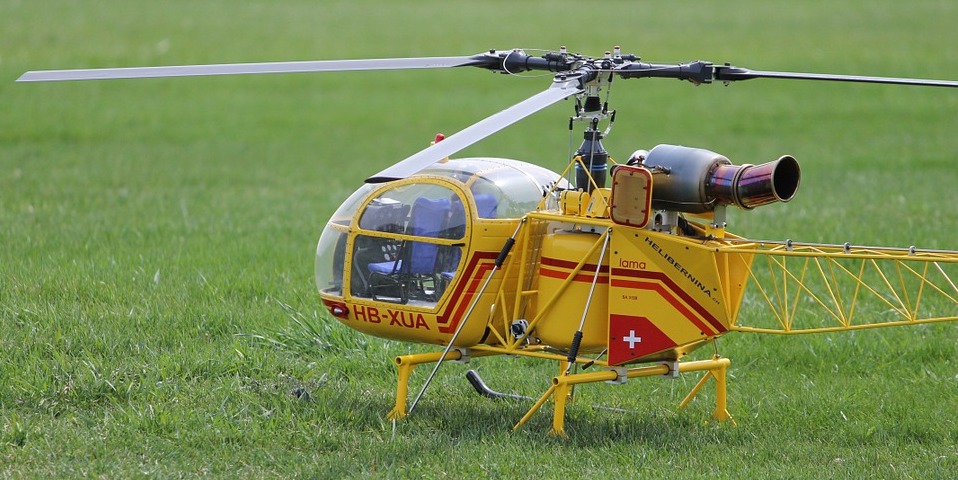How to Fly RC Helicopters
There’s so much more to life than being a passenger. Piloting a new rotorcraft for the first time can be frightening but fun. This article looks at how to fly a remote-controlled helicopter. It’s a simple yet comprehensive introduction for newbies. It’s also a refresher guide for more experienced users.
There are two important safety points to remember before we go any further.
- ALWAYS fly on a fully charged battery for each session
- NEVER fly your helicopter around people, pets, or other animals
You don’t want to hurt people or animals, and you don’t want to smash your new model into smithereens. It’s easy to launch helicopters but having full control takes skill. These crafts are fragile compared to RC planes, so a little patience and persistence go a long way. Once you get good at piloting helicopters—and you will—the rewards are phenomenal.
About this RC Helicopter Guide
This guide doesn’t go into micro details on how to fly and control RC helicopters. Although the models share many similarities, they also have their distinct features. What you’ll learn here are the things to take note of and those to avoid. It won’t take long before you become an accomplished pilot.
Getting Started
Try not to run before you can walk, as the saying goes. It will only end in tears if you do. It’s good to be eager, of course. But over enthusiasm results in impatience and the consequences of that. You wouldn’t ride in a real helicopter with an overexcited, inexperienced pilot, would you?
It’s essential that you pace yourself and master one skill at a time. Look at it as a challenge and an enjoyable one at that. Learning becomes easier the more you know about your craft. An effective way to proceed is to draw up a plan or training schedule. Look at this structured approach as a box-checking exercise. Don’t move to the next phase before you’ve mastered the current skill.
Make sure you know the maximum battery life (flight time) of your craft. Makers of RC copters measure battery life in minutes typically from five to ten. Also, consider the battery recharging times. You can then work your training schedule around these. You might want to invest in one of two spare batteries to continue the fun and training between charges.
Tip: Allow a few minutes for the motor to cool down between battery swaps.
Here’s what we’re going to look at in the rest of this guide:
- The radio transmitter
- What to look for in your first model helicopter
- Coaxial rotors (coax rotors) single rotor
- How to protect your craft
- Where to practice flying skills
- What to practice
- Maintaining your RC helicopter
#1 Get to Know Your Transmitter
Radio transmitters put you in the pilot’s seat, and they all share similar functions. The designs, layout, and options can change between models, though. It’s vital to get familiar with your transmitter so that it feels like a natural extension to your hands.
All RC transmitters (toy and hobby-grade) share the following flight controls:
- Throttle: used to control the helicopter’s height
- Trim: used to control the left/right lateral movements
- Rudder: used to control forward/backward movements
The more channels a transmitter has, the more likely it is to have extra controls. I suggest an RC transmitter with only 2-3 channels for beginners. Extra channels let you travel in more directions, but it can be confusing at the entry-level. You can always opt for additional channels later if you want to.
#2 What to Look for in Your First Model Helicopter
My advice is to go for something cheap and perhaps toy-grade to begin with. Every beginner experiences collisions and crash landings as they develop skills. You won’t cherish a cheap toy copter as you would a beautiful, costly hobby-grade model. You can then practice with more confidence. You won’t have to worry so much about banging, scratching, or breaking parts.
Toy choppers are not as impressive or as capable as hobby-grade models. Even so, the basic flying principles are the same, and that’s the point.
#3 Coaxial Rotors Vs. Single Rotor
It’s easy to overlook this at the buying stage and to go for what appeals to you most. Coaxial rotors consist of a pair of rotors where one sits above the other on concentric shafts. Choose Coaxial rotors if you’re new to flying RC helicopters. They do make the craft less agile, but they’re a lot more stable in the air than single-rotor choppers. A steady bird is just what you need at the entry-level.
Check Coaxial RC helicopters details and prices here
Go here to see what a typical high-end hobby-grade single rotor chopper offers.
#4 How to Protect Your Precious Craft
No pilot wants to smash their RC helicopter into the ground, but most do—especially novice users. All it takes is a single wrong move, a poor decision, or some other event to throw you off course. You can’t make your model indestructible, but you can add an extra layer of protection.

RC helicopter training gear comes in carbon fiber, wood, or fiberglass materials. It provides better balance and thus helps to reduce the risk of crashes and collisions. Training gear also protects rotor blades and other parts from striking obstacles in an accident.
The seven commonsense measures below can also help to protect an RC chopper:
- Avoid flying in winds above 15 mph
- Don’t fly in the rain
- Coaxial Rotors (see point 3 above)
- Choose a safe place to fly (see point 5 below)
- Maintain your RC helicopter (see point 7 below)
- Fly close and low as you develop your skills
- Pay attention to the craft’s sounds (any changes may indicate a problem)
#5 Where to Practice and Develop Your Flying Skills
Practice in an indoor space if you’re new to RC choppers. Indoor flying is easy with lightweight toy-grade models. An enclosed patio or large garage are good for the purpose. The good thing about training indoors is that there are no distractions or interference from the elements. Taking off and landing in a controlled indoor environment with a smooth surface helps to build confidence.
#6 What to Practice First
You’re sure to get better if you allow yourself time to develop. Try not to push too hard and embrace a little patience as you train. Persistence always pays off in the end. Think baby steps and let your proficiency develop naturally. The best approach is to start off low and to keep the helicopter close. Try to resist the desire to fly far and high at this point.
So, what do I mean by flying low and near? There’s no fixed suggestion per se, but as a rough guide stay around the 3-feet mark (1m). And keep a distance from the craft of around 6-feet (2m).
Tip: Know your max flight time. You can fly further and higher as you gain experience but recognize your limitations. You don’t want to be too high or too far away only to run out of power.
Practice the following basic maneuvers first in the order listed below:
- Lifting off
- Landing
- Flying in a straight line
- Liftoff, turn to the right for a full circle, land
- Liftoff, turn to the left for a full circle, land
- Figure eight hover routines
RC helicopters with more than three channels can perform additional maneuvers. Some examples are changing the nose direction, translational lifts, and other more complicated moves. The options you have depend largely on the model’s capabilities and its transmitter.
#7 Maintaining Your RC Helicopter
Basic maintenance helps the longevity of your copter and reduces the risk of accidents. There should be maintenance checks in the user manual that come with the model. Check the tightness of the rotors before each flight. You also want to learn how to adjust the tracking of the blades.
Here are a few other pre-flight checks that you need to make routine:
- Check all flight-critical nuts and bolts before take-off (vibrations can loosen these)
- Check that there’s no looseness with the ball links
- Check the wiring for looseness, breaks or cuts
- Check radio functions including range check for potential interference
- Check the trims haven’t knocked out of position
- Check the tail belt tension if your model has one
- Fully charged receiver, helicopter, and radio batteries
Different models are sure to have some checks that are unique to them. Get familiar with your craft and into the habit of performing pre-flight checks as a matter of routine.
Summing Up
Watching the experts fly radio-controlled helicopters is great entertainment. Flying them is even more enjoyable. But why be a spectator when you can be the pilot of these incredible crafts? Flying RC copters may not be easy, but it’s immensely rewarding once you graduate as a skilled operator.


Great article, THANK you
What made you lead this article with an image of my Starwood Lama turbine model?